Copyright 2020 - 2021 irantour.tours all right reserved
Designed by Behsazanhost
Qashqai Nomads,The Heroes of the Fars ancient plain
Qashqai Nomads, The Heroes of the Fars ancient plain
The Qashqai is one of the largest and most famous tribal confederacies in Iran. They compose a community of settled, semi-settled, and pastoral nomadic households who reside mainly in the Fars region. The confederation is divided into five major tribes and several minor ones. All of these tribes have a common political history, a shared cultural and linguistic heritage, and present social ties. Qashqai speaks the Qashqai language, a dialect of Turkish closely related to Azerbaijani. Most Qashqais are bilingual in Qashqai and Persian (Farsi), and there are a lot of borrowed Persian words in their own language. The actual Qashqai language has not been reduced to writing.
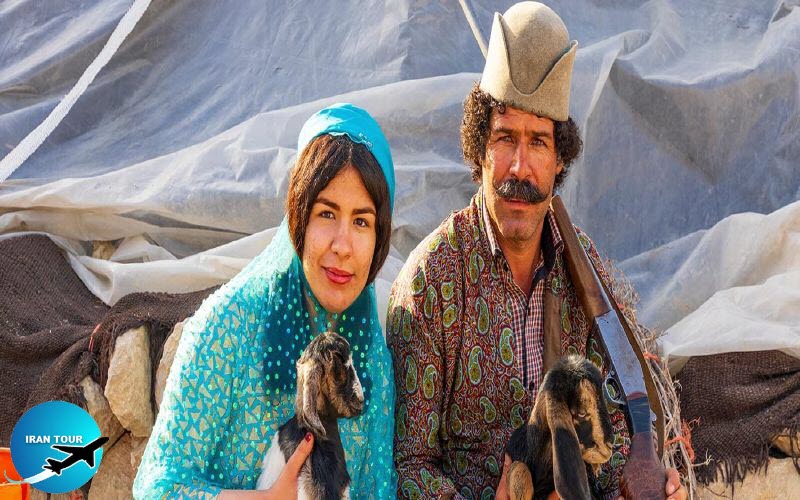 |
-History of the Qashqai
Nothing is known about the origin and early history of the Qashqai tribe. Some name Kashgar, in the remote corner of Central Asia close to China, as their original homeland, and claim that Qashqais came to Iran with Genghis Khan. Others believe that they are related to the Oghuz Turks (later the Turkmen) or their close allies, the Khalaj Turks. Both of these ethnic groups were remnants of the Massagetae tribes, a constant threat to the Iranian borders from at least the time of Cyrus the Great, who was killed by them in battle. Still, others presume that the Qashqai penetrated Iran from the Caucusuas, and are of the Aryan, rather than the Yellow race. Whatever the true origin of the Qashqai may be, authorities concur that the migration of these people took place in several waves, none of which predated the 14th century,
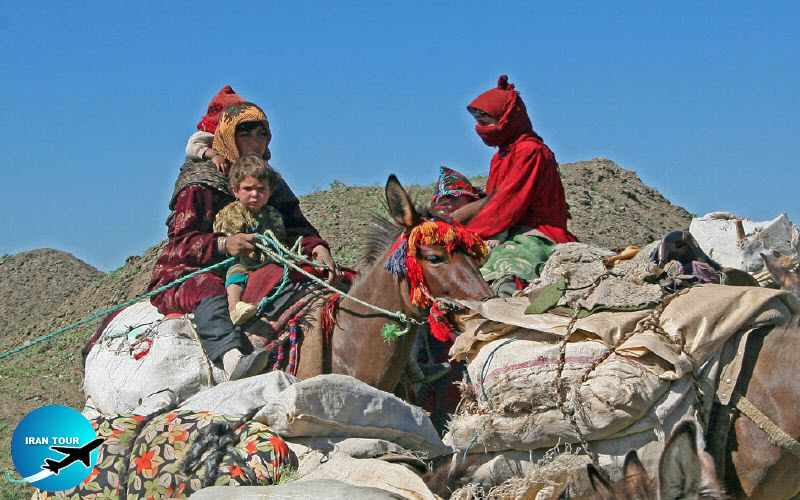 |
The Qashqais were united as a confederation of tribes under their preeminent Safavid-era leader, Jani Aqa Qashqai, who was given authority over the tribes of the Fars region by Shah Abbas. It seems that the name of the tribe is also derived from this person. In his day, the Qashqai confederation became one of the best-organized and most powerful tribal confederations in Iran. The Qashqai gradually built up such great power that they became a threat to the centralized government. Under Nader Shah, in order to fragment their influence, some of the groups of the confederation were forcibly transferred to Khorasan, but during the Zand period, most of them returned home. The heyday of Qashqai prominence was during the 19th century and the early years of the 20th. Although there were ebbs and flows, at that time the Qashqai became increasingly hierarchical and centralized. During the Qajar rule, the Qashqai were active participants in the country's po| political life and even claimed autonomy.
To counterbalance their power, the confederation of the Khamseh tribes (see below) was created by the Qavam family, the richest merchants of Shiraz. The two groups were frequently bitter rivals, haying on occasion serious encounters with each other and with the state authorities; these encounters sometimes culminated in physical violence. The Qashqai, however, retained enough strength to defeat, under their most notable leader, Khan Salat al-Dowleh, the British-led South Persia Rifles in 1918. The Pahlavi dynasty sought to ensure its control of the nomads by means of compulsory settlement. Reza Shah saw them as a potential threat to the security of the settled majority in the country, and also believed that no integrated Iranian state as possible whilst the nomadic tribes formed virtual states within the state. As well, the tribes were viewed as an anachronism in modern Iran toward which Reza Shah was striving. In his pursuit of the ideals innate in westernizing and modernizing the country, Reza Shah dealt severely with the tribes. Whenever possible, numbers of tribal folk were transferred in groups to areas distant from their tribal territory, and many attempts were made to force nomads to settle in villages newly built for this purpose. Many tribal leaders were executed or imprisoned, and the vitally essential migrations were either forbidden or greatly curtailed. The consequences were great hardships brought about by the considerable loss of livestock, the impoverishment of the nomadic tribes, and the marked reduction of their numbers. Travelers to Fars in the 1930s have left us moving accounts of tents being destroyed by the authorities, and replaced with dead-straight rows of mud huts. Although this misguided enforcement and attempt to "westernize" the nomadic people may have been politically expedient, it was economically disastrous and moreover, did untold damage to tribal cultures. The Darreshuri subtribe of the Qashqai confederation, famous throughout Asia as horse breeders, lost nearly all of their thousands of horses when forced by the ban against migration to winter in the cold mountains. Quite naturally, soon after Reza Shah's abdication in 1941, nomadism was partially reinstated, and many forcibly settled tribal groups returned to the nomadic way of life.
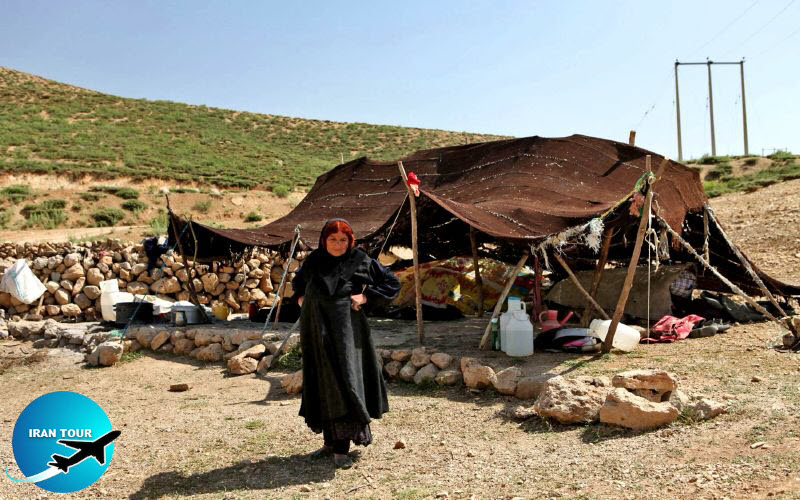 |
The second wave of forced settlement was begun by Mohammad Reza Shah in the mid-1950s. He began by exiling the Qashqai leaders because of their support of Mohammad Mosaddeq's government. In the early 1960s, he nationalized pastures and enacted a national land reform. Simultaneous with the implementation of new land policies, the shah took steps to seize military and political control of the Qashqai people from the tribal khans, and to place that control in the hands of government agents. Rural police (gendarmes) disarmed the Qashqai and subjected their seasonal migrations to military control Following the Islamic Revolution, several former Qashqai leaders attempted to revitalize their tribes as major political and economic forces. Many factors impeded this development, including the decline in numbers, the disorganization of nomadic populations due to their large-scale settlement; and the consequent change in attitudes, especially among youth lured by cities and the settled life. The process of settling the Qashqai, and the further incorporation of these people into Iranian society is still going on. Settled Qashqai are dispersed throughout southern Iran, but the greatest numbers are in rural and urban locations in north-, mid, and south-central Fars. They are engaged in farming and horticulture, while others have found employment in cities.
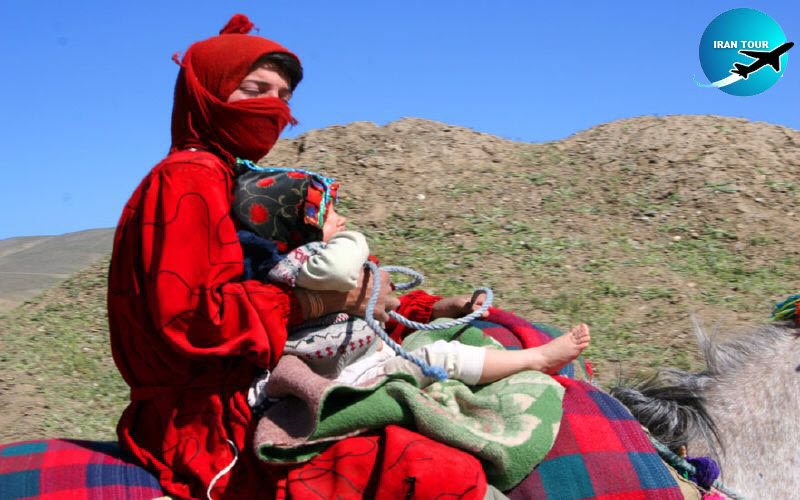 |
-Tribal Hierarchy
Among the Qashqai, the smallest social unit is a family, often referred to in terms of a "tent". Individual families are grouped in Bonku, common herding units, with two to five tents to a unit. These usually settle close to each other and have a common pasture. Several such groups form a clan that usually has around thirty to sixty tents or some 200 to 400 individuals. This is called a Tireh and is governed by the kadkhoda, the lowest administrative authority. Individual tribes within a confederation, called a Taifeh, are headed by a Kalantar, or sub-chief. The sub-chiefs are directly responsible to the chief, who is assisted by a small number of specialized functionaries. The largest tribal confederation, the il, is headed by a paramount leader, the il-khan. The highest echelon of the confederacy administration, from Kalantar to il-khan, wields enormous authority within the tribe, partly because of their birthright and ensuing status as members of noble lineages, and partly because of their wealth. In addition to large herds, they often possess vast plots of pastures and arable land and subsequently rent or lease portions of these to tribes folk or villagers under a variety of agreements, the whole system is controlled and supervised by the appointed agent of the landowner. Rents are most frequently paid in kind, and the situation is economically very advantageous for the rich nomad. Moreover, the wealth of the tribal leaders may be further augmented by the collection of levies from tribal folk. The duties of tribal administration include fixing the times and routes of migration and representing the tribes in their external relations. The lower class of the tribe is made up of those who hire out their labor. These people may serve as full-time shepherds and camel drivers, or as part-time field laborers and sharecroppers. Most such families own some land and small herds of animals. The poorest of the Qashqai are those who have no land or animals. They work for the rich and middle castes and are usually not paid in money, but in food, clothing, supplies, or animals.
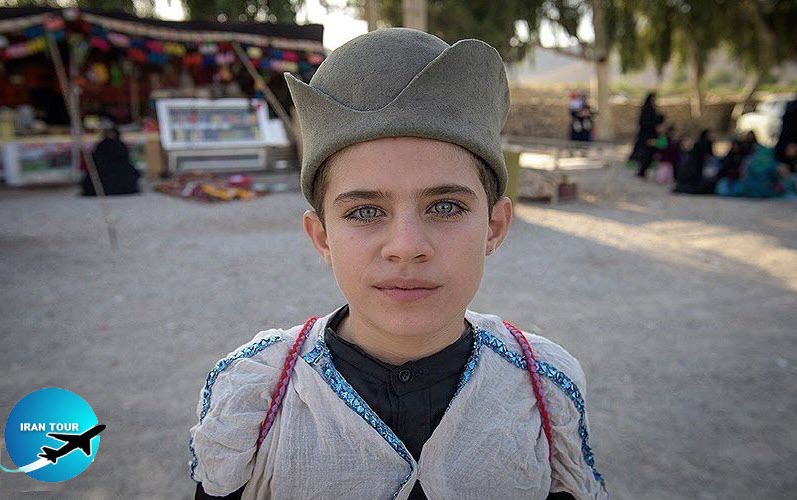 |
- Lifestyle and Migrations
In the many parts of Iran that suffer from the absence of plentiful supplies of water for irrigation projects, the nomadic-pastoral way of life is an admirable human response to existing ecological conditions. Indeed, it is difficult to envisage an alternative lifestyle that would more satisfactorily allow the full utilization of natural resources and at the same time sustain the complex social life and well-being of large communities. The whole of southern and southeastern Iran still runs heavily
on a nomad-type economy. All over the region, the nomadic population migrates in the spring and in the fall, in search of pasturage for their flocks. In summer, Qashqai occupies the high regions of the Zagros, but in winter they have to leave these areas because of the freezing cold. This being the case, they move to the lower territories in the south, where they stay until the long summer season when these areas are fiercely scorched and arid. The migratory routes are followed annually in order to achieve the most advantageous conditions for the animals. In their migrations, Qashqai covers an immense swathe of the country, with their Gyshlaqs, winter quarters, and Yeylaqs, summer quarters, sometimes separated by as many as 600 kilometers. Moreover, their migration routes are considered to be among the most difficult among all those of Iran's pastoral tribes. Consequently, the semiannual migrations, complete with families, flocks, and household equipment, may take up to two months to accomplish. About 20,000 Qashqai families set out on their journey twice a year, leaving behind only a few men to reap the scattered fields which they have sown in the southern region. Their train includes all their animals - cows, camels, horses, donkeys, hens, and dogs - as well as their main source of wealth, sheep, and goats. In more recent years, cars, trucks, and motorcycles have been added as well. Because everything must be packed, and food and brushwood prepared for the route, the rich Qashqais, who are helped by their servants, usually set out earlier than the common tribes folk. Using camels and mules, they also move faster than the rest of the caravan, which has to rely on donkeys. The poorer nomads have their stuff carried by pack animals, but they have to walk all the way.
During migrations, the tribe's trade live animals, wool, hair, hides, dairy products, and various knitted and woven textiles with villagers and townspeople in return for commodities that the nomads are unable to produce. Each tribe claims the use of fixed territories for its summer and winter pastures, as well as the right to use a specific, well-defined migration route between these areas. Not surprisingly, nomads know by name every smallest plot of land and every water spring along their way.
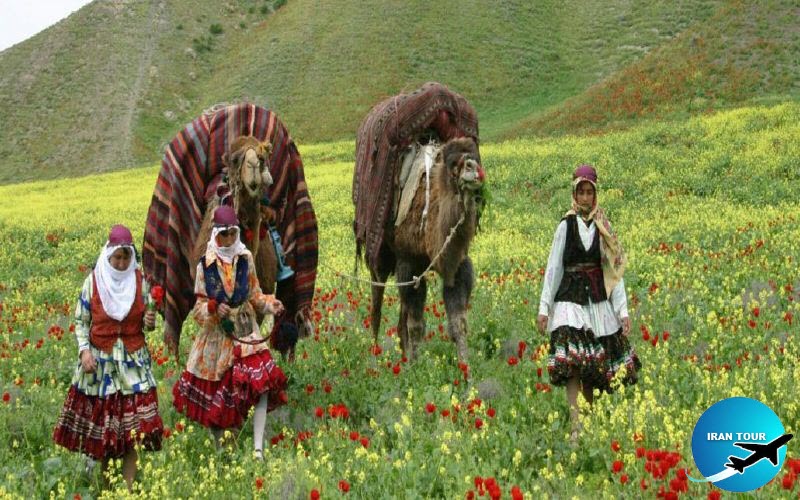 |
-Major tribes
The Kashkuli-ye Bozorg tribe moves from the valleys around Gachsaran and Kazerun to the southern foothills of Dena and around Sepidan. The Amaleh spend the winter in Firuzabad, Khonj, and Larestan, and move to Semirom for the summer. The Darreshuri live in a community with the Amaleh, and spend the winter in Khonj and Lar, and the summer in Semirom. The Farsimadan go from Kazerun and Sar-Mashhad to the northern slopes of Dena. The Sheshboluki go from Farashband and Bushehr to Abadeh and Eqlid. Minor tribes: The Kashkuli-ye Kuchak spend winters in Firuzabad, and summers around Sepidan. The Qarachei move from Kazerun, where they stay in winter, to their summer pastures on the northern foothills of the Dena. The Rahimi spend winters in Dashtestan and Farashband, and summers in Semirom and Sarhad. The Safi Khani winter in Farashband, and summer in Abadeh and Sadeh. The Jafar Beiglu's winter quarters are in Afzar, and their summer camps, in Semirom. The Namadi spend the winters in Firuzabad and Farashband, and the summers in Semirom. The Igdar winter in Khonj and Larestan, and summer in Sarhad.
Along the migration routes, each group and subgroup has its own camps, and though this ownership is only occasionally sustained by documentary evidence, it is always recognized by common law. If any group impinges upon the rights of the others, it may be punished by boycotting, or may even become involved in physical fighting Because the flocks need to graze along the route, exact timetabling is required; otherwise, several groups would simultaneously have to pass through an area of limited resources in a short space of time. Moreover, wherever the route of migration approaches or passes through cultivated areas, movements must be strictly controlled to avoid damage to the crops. Tribal leaders take charge of controlling migratory movements and the pastoral groups' successive tenure of grazing land along the trail. However, a considerable degree of cooperation from government agencies is often rendered necessary. Summer migrations usually start in mid-March, and winter migrations in late October, but both can begin earlier or may be delayed up to one month, depending on weather conditions.
Their livestock is the most important asset of the nomads. Consequently, pastures for grazing are the greatest necessity. In the past, there were enough pastures for all, but over time, with the number of animals has greatly increased, the nomads were obliged to buy or rent additional pastures, or else sell out their stock and seek to augment their income by other expedients. These were usually linked with the sedentary communities and included seasonal occupations such as harvesting, guarding winter crops, acting as village shepherds, and the like.
 |
In addition to stockbreeding for use and exchange, nomadic households of Fars rely on different combinations of a variety of employments - such as agriculture, production of handicrafts, and gathering. Exchange of labor, trade, and providing protection and transportation facilities for traders are other potential sources of income for the households. Throughout the year, Qashqai lives in their famous black tents, which are woven of goat's hair and are put up with the help of wooden pegs. During the summertime, part of the tent can be unfolded in order to create a sort of a terrace where the family can stay in the shade and can sleep at night. In winter, a straw fence can be put around the tent to protect it from the wind. An average tent occupies about 20 sq. m; the largest tents (belonging to the rich) may be as large as 40 sq. m.
Inside the tent, the ground is covered with felt, on top of which there are some rugs. Household items are usually placed along the long rear wall and covered with a rug or a piece of cloth. Foodstuffs and some items used on a more regular basis are stored in the right corner of the tent. The rich and the poor usually have the same array of household items, which may differ only in their quality and number. The entire family sleeps on the floor, with the husband and father sleeping close to the entrance to guard his family and stock. There is no barn or the equivalent; the animals stay in the open air just outside the tent. If a guest! sleeps together with the family, the tent! is divided in half by a piece of cloth to separate the men's and the women's areas. In front of the tent, two fireplaces are built. One is for women, to cook food and bake bread; the other is for men, to prepare tea and coals for hookahs.
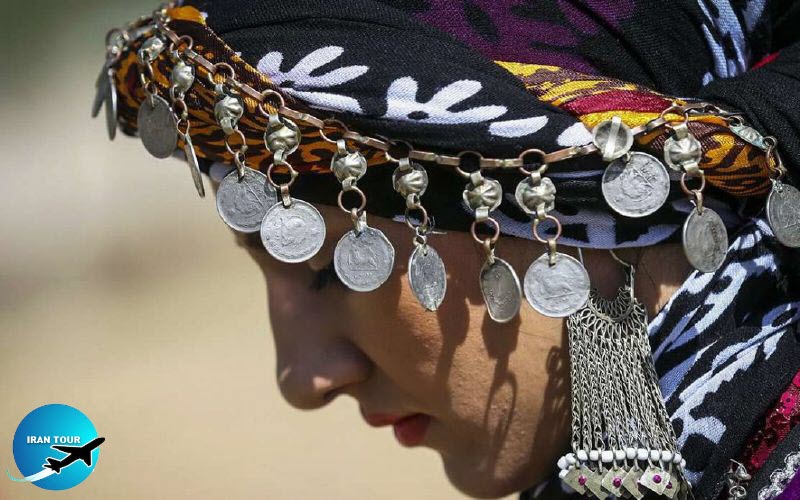 |
-Clothes
Qashqai tribes are well-known for the colorful clothes of their women. These include full, multi-layered, lurex-decorated skirts; knee-length, long-sleeved tunics with long slits on either side; and shawls of light, often transparent cloth, which cover the women's hair, neck, and shoulders. Although most women prefer very bright, even garish colors, elderly women tend to wear dark clothing. Widows always wear black. Qashqai women are very discreet with their makeup, which includes only henna and kohl; and with their jewelry, the most common items of which are bracelets, glass beads, coins, and sometimes charms or written prayers to ward off evil. Women never cut their hair short; they wear it parted in the middle and plaited. Married women cut their front hair to chin length to frame their faces.
Qashqai men wear distinctive felt hats, dome-shaped, with a wide brim separated in front into two sections which turn up against the dome and flare out slightly at the top; long, loose overcoats with slits on both sides, fastened with large pieces of fabric, usually white or brown; and wide trousers of thick cloth. Both men and I women wear cotton shoes, called Giveh.
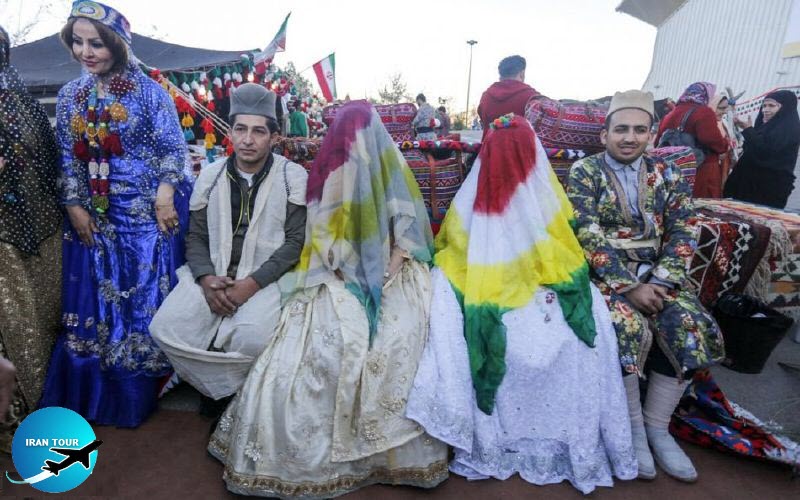 |
-Marriage and Wedding
Ceremonies Marriage among the Qashqai is considered a righteous act, and being single is a sin. It is usually based on a caste system and is consummated only at the parents' agreement. Marriage between close relatives, particularly patrilateral and matrilateral cousins (especially first cousins), is the preferred pattern. It is encouraged because firstly, a bride and groom know each other to some extent, and secondly, it is easier to reach an agreement over the dowry money and prenuptial issues. Some families, however, marry members of other subtribes, and so establish more extensive ties.
Polygamous marriages are very rare and are generally discouraged. A man may take a new wife only if his first marriage is childless, or if he has only girls born in it. Among the Qashqai, only male descendants are considered the proper" children of the family. The more numerous a man's sons, the more adequate his labor force for herding. Often the pity and contempt of fellow tribesmen toward the family who do not have boys make a husband take a second wife even if he does not want to do so. In this case, it is customary for the first wife to choose the new wife for her husband.
Marriage is thus necessary as a means of maintaining social status and as a legal way of procreation, and love is perhaps the last thing considered. However, although it is not rare for a bride and a bridegroom to see and talk to each other for the first time during their wedding, many couples learn to love one another over time. In any Qashqai family, the husband holds supreme power; his word is final, and not open to appeal. In some cases, however, he may encourage his wife
and children to give advice and suggestions and to participate in the discussion of important family matters. Hence, for some young men, marriage is the only way to escape their father's dominance.
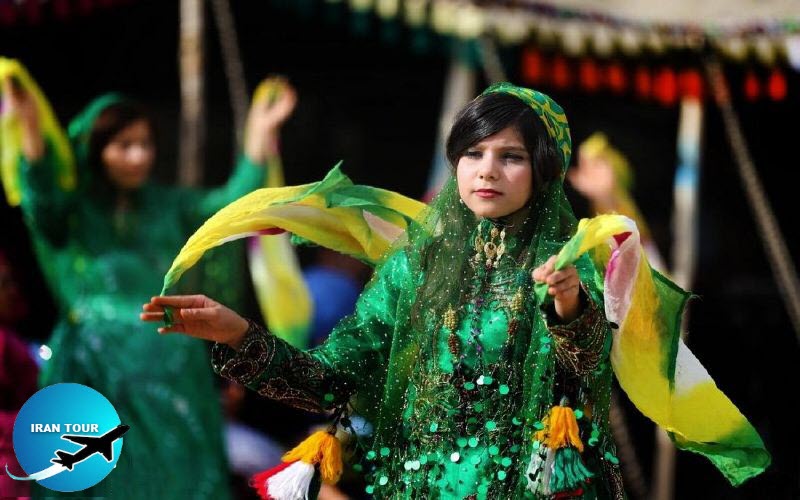 |
A bridegroom is always older than his bride, and marriage between a 35-year-old man and a 15-year-old girl is rather a rule than an exception. The parents of the bridegroom are usually the initiators of a marriage. They usually begin by asking a tribal elder to act as a go-between in their negotiations with the bride's family. Because of the great respect in which this person is held, the bride's family often feels incapable of giving him a negative answer. When a primary agreement is achieved, the bridegroom's relatives pay a visit to the family of the bride and ask her parents to give their daughter's hand in marriage. Even if the answer is positive, it is seldom given in less than two month's time. Now it is becoming common at least to ask the girl what she thinks about the marriage, but her opinion is of little value if her parents have already made up their minds. After two months, the female members of the bridegroom's family bring their first gifts to the bride. The bride's mother also gives a small party, called a Shal-angosht, to which she invites her female relatives and friends. After this ceremony, the two families establish closer relations. Shortly afterward, the elder men from both sides meet to discuss the amount of money to be paid by the bridegroom to the bride; part of this money is usually spent for the dowry, and part is kept as a sort of insurance paid to the woman in case she is divorced. Often, this is not cash, but valuables or livestock. At long last, a fortunate day for a wedding ceremony is calculated according to the stars. The entire community is involved in the preparations; many of the guests bring with them the things that will be used during the wedding ceremony, such as rice, mutton, cash money, etc. The wedding may last for several days and is accompanied by the continuous serving of tea and food, listening to music, horseback riding, and wrestling contests, and kerchief dances.
One of the most important rituals of the wedding is bringing the bride to the bridegroom. Sometimes, if she lives a long distance from the wedding site, she may be brought to the camp of her intended husband a day before the appointed date, and put in a tent without being seen by him. There her female relatives assist her in preparing for the ceremony. On the wedding day, the guests, accompanied by the musicians, go to the bride's tent. There, covered by a white veil, she is set on a horse, and her dowry is packed on camels and mules. Usually, a young boy sits in a saddle behind the bride to ensure that her first child will be a boy. When the caravan arrives at the bridegroom's tent, he helps her to dismount, and his mother pours sweets and coins on them. At the end of the first day of the wedding, the bride gives a small keepsake to each guest. Then a family elder takes the couple to their tent, which is embellished with myrtle as a symbol of fertility and
 |
-Other Holidays and Traditions
The Qashqai are Shiite Muslims, but religion generally sits very lightly on them. They do, however, follow the Islamic rites of marriage and death, and observe most Islamic traditions. It also seems that the Moharram mourning ceremonies are held with much greater pomp among the tribes than in Iranian cities. Like
most Iranians, the Qashqai celebrate Nouruz. They also have many holidays and traditions of their own.
One of the ceremonies peculiar to the tribe is called Chelleh-be-dar, celebrated 45 days after the beginning of winter. This is believed to be the time when winter loses its grip on nature and starts fighting against the coming spring. In the evening, people kindle bonfires and make their sheep pass through the fire with great rapidity; the nomads believe this will keep the animals healthy. Because the next day, tents on the winter pastures will be moved to another site, and people living in a neighborhood will be separated, there is usually a farewell gathering.
The next holiday is celebrated on the first day of Esfand, which, according to the calendar, is the last winter month, but in the Fars region is the beginning of spring. Esfand is the birthing season for sheep, and there is an abundance of dairy products at that time. On this day, colorful patches are painted on the sheep, because people believe that they should make the animals as bright as the world around them. In the evening, bonfires are kindled, and young boys and girls jump over them. When the fires are put out, the Qashqai cover them with stones to protect the ashes. The next morning they check the ashes, and when they find in the ashes a depression similar to the footprint of a sheep or a camel, they believe this means that next year they will be able to afford a new camel or sheep for their flock or herd.
The Qashqai still sometimes observe an ancient rainmaking ceremony called Kuseh-gelin. A young man puts on black clothes, a beard, and a pair of horns, and colors his face with coal and flour. A noisy crowd of his friends follows him as he moves from tent to tent, chanting a special song. Tribesfolk usually gives the singers small gifts.
Among the Qashqai, the next most important family ceremony, second only to the wedding, is the circumcision of boys. Many guests are invited for a very substantial meal and are usually given small presents by the boy's family. The Qashqai believe that the group of boys circumcised should not total an even number, so to avoid this, many extend an invitation for a boy from another family to be circumcised in their ceremony. There is an established tradition for a rich family to invite a boy from a poor family to join their sons. In this case, the host family pays all the expenses related to the circumcision of the children.
A very elaborate ceremony is connected with the burial of the dead. First, the body is washed, often with the help of numerous family members and friends, and wrapped in a cloth or a rug. If the person dies during the daytime and all of his/her relatives are nearby, the burial may be held the same day. If there is a need to wait for the relatives to arrive, the deceased is put inside the tent, and a candle is lit above the head. Because the Qashqai believe that wild spirits may enter the body if it is left alone, someone, often the mullah* saying prayers, remains by the body. During the ceremony, the body is placed on a litter, covered with a black cloth, and carried out of the tent. It is put on the ground and lifted again three times. Then the body is taken to the graveyard, usually located beside the building of a local Imamzadeh. There the body is put in the grave with the head in the direction of qibla*. A mullah is in charge of a burial ritual. When it is over, a candle is lit on the grave, and relatives take care of the fire to make it burn during the first three days, when, according to the beliefs, the deceased is being questioned regarding his deeds, right and wrong. After the burial ceremony, the people gather in the tent of the close relatives of the deceased, where they express condolences and participate in the final repast. Men and women loudly lament, and if the deceased was a tribal elder, drums may be beaten. The ceremonies related to the commemoration of the deceased may last for as long as a year.
Sheep Shearing is an important ceremony for every family owning livestock. Usually, the Qashqai shear their sheep only once a year, in May and June, after the animals have arrived at the summer pastures. The fat-tailed sheep are of a breed well suited to traveling long distances with the migratory caravan, and they have strong, glossy, long-stapled wool. On the appointed day, the sheep are carefully washed in the river. Then a group of young men fences them into a pasture, and a specially-trained master starts cutting off the wool, taking about twenty minutes for each sheep. Next, the wool is gathered and sorted. Some of it is kept for family needs, while the rest is prepared for sale. The poor are usually allowed to collect the remainder of the wool. At the end of the day, the owner of the sheep treats everyone to dinner.
The most favorite and honorable pastime among the Qashqai men is hunting. A good horse and a good rifle are still considered the most precious items among the tribes folk. In the past, expert riders and marksmen even had better chances in choosing a wife. Parents usually encourage their boys to learn to hunt. When a boy goes hunting for the first time, his rifle is passed through the clothes of a baby girl, in the belief that this will bring him luck. If the boy returns with game, his parents
give a dinner or pass out sweets among the neighbors, and make the boy repeatedly describe his feats for everyone. The Qashqai are very superstitious, and in this case, too, parents throw some perfume in the fire to ward off "the evil eye”. In some clans, the boy goes for several days with a red kerchief around his neck as a sign of his glory.
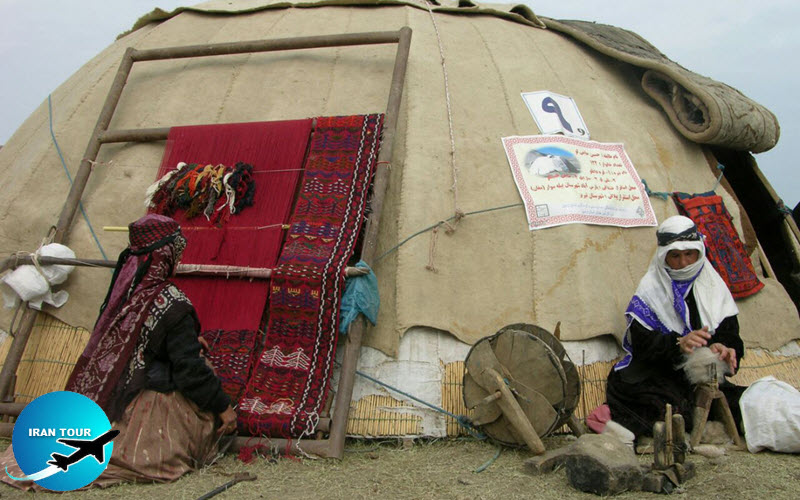 |
-Carpet Weaving and Other Crafts
Qashqai women are acclaimed experts in carpet weaving. Using wool from their sheep and dyes from plants and insects found on their trail, they produce woven objects - floor coverings, bedspreads, horse blankets, and storage and bedding bags - with an instinctive wealth of color and design that has come down through the ages without the aid of written instructions or drawings. They use looms that can be disassembled and reassembled within an hour, though little weaving is done on the migratory journey, and the time of greatest weaving activity is in the summer months.
Most Qashqai pile rugs have a woolen foundation with two wefts and symmetrical or sometimes asymmetrical knots. Side finishes consist of a single cord of the warp overcast in various colors, while the ends are often extra-weft brocaded with herringbone or chequered stripes.
Qashqai kilims are woven in slitweave, sometimes with cotton warps, and sometimes with natural brown wool.
These usually have two different designs:
1) horizontal bands of patterns with borders of finely drawn tulip motifs, frequently linked to a zigzag inner border; and
2) a central field within borders, with diamond medallions lying inside the field, or else a square grid pattern.
As the Qashqai people are mainly nomadic, a large variety of storage bags are woven, and the different sizes and shapes indicate their use. The most popular of these bags is the chatneh, a square bag for storing food during the trip; the tirdan, a long bag for keeping long household items; and the namakdan, a salt bag.
The Qashqai also produces fine jajims, woolen fabrics a bit thicker than a blanket, usually woven in one size but having different colors and patterns.
 |
-Khamseh
The Khamseh is a confederation of five tribes, which in the late 19th century rose to prominence under the leadership of Mohammad Ali Khan Qavam. Despite the common label of “Arabs” attached to these tribes, their members trace themselves back to diverse origins and have no single language. One of the tribes consists mainly of Arabs, one of Persians, and three Turks. With their livestock,
-Mamasani
The nomads of Mamasani, Kohkiluyeh, and Bakhtiari are fundamental of the same origin, so say most of the early Islamic writers, who hold that these tribes lived in Syria prior to their settlement in western Iran. According to other sources, the Mamasani came from Sistan and allegedly descended from the famous Rostam, whose name is still borne by one of its clans. The Mamasani tribe seems to have settled in western Iran in the 16th century. For about a hundred years, they shared the territory with the Shulestani tribesmen, but finally, the Mamasani eliminated most of their enemies, while the survivors were assimilated by the winners. The Mamasani speak the Lor language.
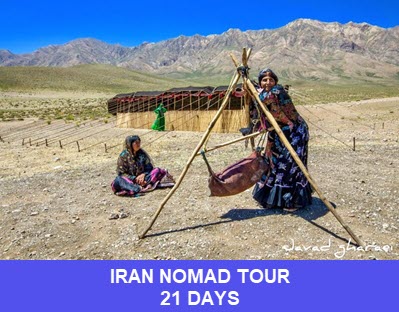 |
 |
 |
- Details
- Category: Shiraz Tourism